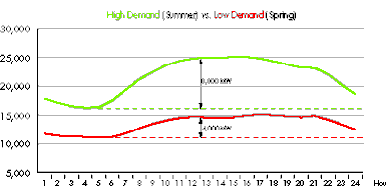This page was published under a previous government and is available for archival and research purposes.
Demand - An updated forecast
A forecast of the demand for electricity establishes the context for long-term planning - it predicts the amount of electricity Ontario will need.
System planning requires a complex forecast of the total amount of electricity that will be used over the course of a year, as well as the amount required to meet peak demand. The next step is to match these requirements with available generation and transmission capacity. Demand fluctuates with the time of day, weather, time of year and the structure of the economy. Ontario’s demand can fluctuate between 11,000 MW on an early Sunday morning in spring to 25,000 MW on a hot Thursday afternoon in summer.
Figure 1: Ontario electricity demand comparison

Unlike other forms of energy, electricity cannot be easily stored. Ontario’s electricity system must be able to produce and move enough electricity to meet the changing demand for it instantaneously - all day and all night, every day and every night.
Ontario is part of an interconnected grid consisting of thousands of generators linked by tens of thousands of kilometres of transmission lines, crossing international, provincial and regional borders. The interconnected nature of the grid, supported by mandatory reliability standards, helps to ensure a stable power supply even when major components fail or when demand exceeds what can be met with domestic resources. Trade in electricity takes place over this interconnected system - for instance, between Ontario, Quebec and the U.S. - on a daily basis. In 2003, Ontario was a net importer and much of this imported supply came from U.S. coal power, which increased prices and reduced Ontario’s air quality. Ontario is now a net exporter of electricity.
Electricity demand in Ontario has declined since reaching a peak in 2005. For the next 10 years, demand is expected to recover from the recent recession and then stay relatively flat as conservation efforts and an evolving economy change Ontario’s energy needs.
Accomplishments
Ontario families and businesses have participated in conserving energy through various government conservation programs and shifting the demand away from peak hours.
- Ontario’s conservation initiatives have been successful. Since 2005, Ontarians have saved enough energy to meet the combined electricity demand of Mississauga and Windsor.
- Peaksaver®, a residential and small business electricity demand reduction program that temporarily powers down central air conditioning systems, has conserved enough to power a community the size of Thunder Bay.
Future Needs
Demand is recovering slowly in 2010 after the global economic recession. Future demand will depend on a number of factors including: the speed of Ontario’s economic recovery, population and household growth, greater use of electronics in appliances and home entertainment systems, the pace of the recovery of large, energy-intensive industry and the composition of the economy (e.g. a shift to more high-tech and service jobs). Demand will also be impacted by the success of conservation efforts, as well as the potential electrification of public transit and the number of electric vehicles on the road. Weather can also have a pronounced effect.
To account for generation maintenance, extreme weather or significant changes in the amount of electricity the province needs, it is important to have electricity capacity in reserve.
The Plan
Based on OPA analysis, this Plan outlines three potential scenarios (net of conservation) for electricity demand:
- Low growth (yellow) assumes that Ontario’s manufacturing and industrial sectors continue to grow modestly in accordance with the current trend. Some of the recent decline in consumption is due to conservation, some to restructuring in the various industrial sectors, and some due to the recession. This forecast assumes a lower rate of population growth than in the other two scenarios. It further assumes that only 13 per cent of people use electricity for heating and that small appliance use accounts for 30 per cent of growth.
- Medium growth (brown) represents moderate growth in the industrial sector and in population. This scenario assumes continued growth in the residential, commercial and transportation sectors. This forecast assumes that there is a consistent move towards high-tech and service industries and somewhat higher provincial population growth than the low growth scenario. This scenario is consistent with the current government goal for electric vehicles: five per cent by 2020.
- High growth (orange), or aggressive electrification, assumes that there is a significant increase in electric transportation - both public and private. It assumes that there is aggressive North American greenhouse gas regulation, faster population growth than the low growth scenario, significant industrial change and that by 2030 about 12 per cent of vehicles on the road are electric.
Figure 2: Range of energy demand forecast

The three scenarios do not differ significantly until 2018, allowing time to adjust as the Long-Term Energy Plan will be updated every three years. For planning purposes, the government is using the medium growth line to predict future electricity needs. The medium growth scenario balances the expected growth in residential and commercial sectors, with modest, post-recession growth in the industrial sector. The addition of 1.1 million households and the expected increase in the use of entertainment electronics, and small appliances will increase residential electricity demand. The addition of 132 million square metres of commercial space and the associated use of air-conditioning, lighting and ventilation will increase electricity demand in the commercial sector.
Based on the medium growth scenario, Ontario’s demand will grow moderately (15 per cent) between 2010 and 2030, based on the projected increase in population and conservation as well as shifts in industrial and commercial needs. As a result, for planning purposes, the system should be prepared to provide 146 TWh of generation in 2015 rising to 165 TWh in 2030.
Ontario is also planning to create sufficient flexibility in the system to accommodate the higher growth scenario.